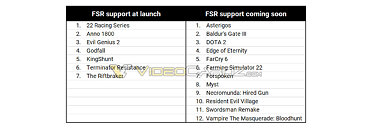Thursday, June 17th 2021

AMD FSR Supporting 7 Games at Launch, 12 More Games to be Added in the Near Future
AMD's DLSS competitor FidelityFX Super Resolution (FSR) is going to be launched in a mere five days, on June 22nd. When AMD announced the technology last month, they used Godfall as a showcase for the improved performance characteristics of the technology, which should aid (particularly) in raytracing.enabled games. Being open source, AMD's FSR also supports NVIDIA's graphics cards, meaning that any game that bakes in support for the technology can be taken advantage of by PC players irrespective of GPU brand.
In the meantime, the launch titles for FSR have become known, and there are seven of them, though they're relatively small hitters (Anno 1800 is one of the supported games at launch). However, support for FSR is expected to launch in the near future for 12 more games, including heavy-hitter Baldur's Gate III, DOTA 2, Far Cry 6, Myst, Resident Evil Village and Vampire the Masquerade: Bloodhunt. Besides these closer-to-the-horizon games, a number of developers have announced they're working on integration FSR on their workflows, including Crystal Dynamics, Focus Home Interactive, Capcom, Ubisoft, Unity, Electronic Arts & Dice... A total of 44 developers in all, Of course NVIDIA's DLSS supports much more games - but remember it has two years in the market going for it, and remember that DLSS 1.0 wasn't all that good. So comparisons with NVIDIA's solution and claims of failure or disappointment on AMD's technology might be slightly too early judgments, especially considering how this tech has also been announced to be supported by Microsoft's Xbox Series X|S consoles.
Source:
Videocardz
In the meantime, the launch titles for FSR have become known, and there are seven of them, though they're relatively small hitters (Anno 1800 is one of the supported games at launch). However, support for FSR is expected to launch in the near future for 12 more games, including heavy-hitter Baldur's Gate III, DOTA 2, Far Cry 6, Myst, Resident Evil Village and Vampire the Masquerade: Bloodhunt. Besides these closer-to-the-horizon games, a number of developers have announced they're working on integration FSR on their workflows, including Crystal Dynamics, Focus Home Interactive, Capcom, Ubisoft, Unity, Electronic Arts & Dice... A total of 44 developers in all, Of course NVIDIA's DLSS supports much more games - but remember it has two years in the market going for it, and remember that DLSS 1.0 wasn't all that good. So comparisons with NVIDIA's solution and claims of failure or disappointment on AMD's technology might be slightly too early judgments, especially considering how this tech has also been announced to be supported by Microsoft's Xbox Series X|S consoles.



43 Comments on AMD FSR Supporting 7 Games at Launch, 12 More Games to be Added in the Near Future
Posted by
u/AMD_Mickey
Radeon Community Team
14 days ago
Quick Update Regarding FidelityFX Super Resolution on RX 470 and RX 480
Hi all,I just wanted to pass on the news that we are updating the list of compatible AMD graphics for FidelityFX Super Resolution (FSR) to include Radeon RX 470 and RX 480.
We expect the website to be updated with this information sometime soon and we wanted to make sure you were aware.
Looking forward to having you all try FSR out on the 22nd. ✌️
Cheers.
-Mickey
..for their games to look worse.
Nobody stops them from using native / scaled resolution. Neither should anyone stop them from using FSR. Both FSR and DLSS are great techs that will only get better with time.
I don't expect to be close to native. I expect it to be barely OK at 1080p, average at 1440p and acceptable at 4K.
I expect it also to be better than just raw resolution scaling option many game have but worst than DLSS2.0.
It is also much easier to add support for it to a game (unlike TAA derivatives such as DLSS 2), no need in motion vectors etc.
FSR is about all cards and APU.
This means some older IGP/APU could run the game in 1080p max detail using FSR/720p internal resolution.
And actually, that will be a good case to verify what are the advantage of FSR vs in game resolution scaling. DOTA 2 already have a internal resolution scaller so we should be able to compare it with the in game feature to see if it's a marketing gimmick or if it have real advantages versus current implementation.
But again, if people think that FSR like DLSS 2.0+ will be equal or better quality than native, people will be really disappointed.
That being said, comparing TAA derivatives like DLSS 2 to FSR needs some nuance.
The former will shine where TAAs shine, and do poorly where TAA does poorly (quick motion, small details etc).
I'd highly disagree with your opinion.